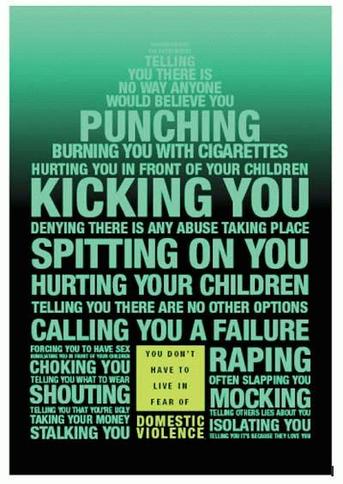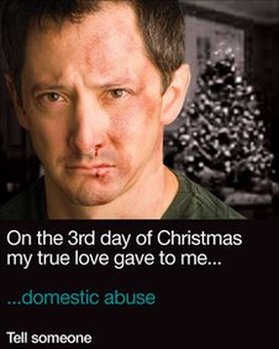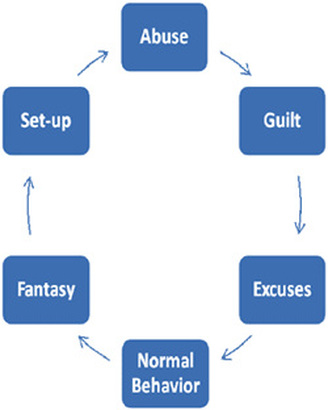TYPES OF ABUSE

Domestic Abuse: Occurs when an individual in an intimate relationship is dominates and control their partner. Domestic Abuse includes physical violence and emotional abuse.
Physical Violence: Is one of the four types of intimate partner violence (IPV). It is a deliberate violent and aggressive act that causes both physical and psychological harm to the victim. Physical Violence includes: pushing, shoving, hitting, slapping, kicking and physically hurting someone. Physical violence has negative consequences on women’s reproductive health. Pregnant victims could also suffer from miscarriages, still births, fetal fractures and premature labor. Long term effects include chronic pain, depression and disability as well as cause alcohol abuse (PRAMS, 2006).
The prevalence of physical violence against women decreases as household income increases (PRAMS, 2006). This could be because these men (who are violent) see themselves as the dominant individual of the household. Low income may result in them feeling inadequate and threaten their control of their household and as a consequence result to violence to establish the control they want. Research by Rennison and Planty (2003) found that violence is largely associated with social and economic isolation. They discovered a clear link between the low household income and intimate partner violence.
Sexual Abuse: Sexual abuse is non-consensual sexual contact. Sexual abuse by an intimate partner can include derogatory name calling, refusal to use contraception, deliberately causing unwanted physical pain during sex, deliberately passing on sexual diseases or infections to cause pain or humiliation (Pandora’s Project, 2009).
Battering: Is a form of physical violence that is a chronic, constant physical assault in which the victim suffers from psychological vulnerability and a loss of control due to the partners use of power through physical, sexual and psychological force (Coker, Smith, McKeown & King 2000).
Emotional Abuse: Emotional abuse aims to reduce self worth and self confidence. A victim of emotional abuse often feels she has no choice but to remain in the abusive relationships. (Helpguide, 2010) Although Physical and emotional abuse occur at the same time women often report that emotional abuse has a more severe and long term impact on their well being, than the physical bruises as a consequence of physical violence (Follingstad et al, 1990 as cited in Katz & Arias, 1999). Arias and Pape (1999) write that psychological abuse has been found to be significantly related to psychological adjustment. This therefore shows emotional abuse to be as detrimental if not more damaging than physical abuse and violence.
Psychological Battering: Psychological battering characterises the experiences of the women who may not be physically or sexually abused and battered. However, they still experiences extreme fear, loss of control and power and feel entrapped which corresponds with battering (Coker et al, 2000)
Financial Abuse: Financial abuse is a more subtle form of emotional abuse and includes restriction of spending. Preventing the victim from pursuing a successful career, stealing from the victim, as well demanding daily account for any money they (the victim) has spent.
Verbal Abuse: Often coupled with emotional abuse, verbal abuse includes yelling, name calling, blaming and shaming (Helpguide, 2010).
Physical Violence: Is one of the four types of intimate partner violence (IPV). It is a deliberate violent and aggressive act that causes both physical and psychological harm to the victim. Physical Violence includes: pushing, shoving, hitting, slapping, kicking and physically hurting someone. Physical violence has negative consequences on women’s reproductive health. Pregnant victims could also suffer from miscarriages, still births, fetal fractures and premature labor. Long term effects include chronic pain, depression and disability as well as cause alcohol abuse (PRAMS, 2006).
The prevalence of physical violence against women decreases as household income increases (PRAMS, 2006). This could be because these men (who are violent) see themselves as the dominant individual of the household. Low income may result in them feeling inadequate and threaten their control of their household and as a consequence result to violence to establish the control they want. Research by Rennison and Planty (2003) found that violence is largely associated with social and economic isolation. They discovered a clear link between the low household income and intimate partner violence.
Sexual Abuse: Sexual abuse is non-consensual sexual contact. Sexual abuse by an intimate partner can include derogatory name calling, refusal to use contraception, deliberately causing unwanted physical pain during sex, deliberately passing on sexual diseases or infections to cause pain or humiliation (Pandora’s Project, 2009).
Battering: Is a form of physical violence that is a chronic, constant physical assault in which the victim suffers from psychological vulnerability and a loss of control due to the partners use of power through physical, sexual and psychological force (Coker, Smith, McKeown & King 2000).
Emotional Abuse: Emotional abuse aims to reduce self worth and self confidence. A victim of emotional abuse often feels she has no choice but to remain in the abusive relationships. (Helpguide, 2010) Although Physical and emotional abuse occur at the same time women often report that emotional abuse has a more severe and long term impact on their well being, than the physical bruises as a consequence of physical violence (Follingstad et al, 1990 as cited in Katz & Arias, 1999). Arias and Pape (1999) write that psychological abuse has been found to be significantly related to psychological adjustment. This therefore shows emotional abuse to be as detrimental if not more damaging than physical abuse and violence.
Psychological Battering: Psychological battering characterises the experiences of the women who may not be physically or sexually abused and battered. However, they still experiences extreme fear, loss of control and power and feel entrapped which corresponds with battering (Coker et al, 2000)
Financial Abuse: Financial abuse is a more subtle form of emotional abuse and includes restriction of spending. Preventing the victim from pursuing a successful career, stealing from the victim, as well demanding daily account for any money they (the victim) has spent.
Verbal Abuse: Often coupled with emotional abuse, verbal abuse includes yelling, name calling, blaming and shaming (Helpguide, 2010).

Domestic Abusers use a variety of tactics to establish and ascertain their power and control over their victims. This also ensures that the victim has low self esteem and low self worth that they blame themselves for the abuse they suffer and life predicament and don’t have enough esteem to walk away from the relationship.
Ø Dominance – The abuser feels the need to be in charge, and therefore makes all the decisions and may even treat the victim as a possession only.
Ø Humiliation – The abuser will do as much as possible to make their victim feel worthless as this makes them unlikely to leave. Public insults and name calling are weapons used to lower the victims self esteem and self worth.
Ø Isolation – The abuser will isolate the victim from friends and family and the outside world. This will then increase he victims dependency on the abuser, who can then use the supposed lack of family support as a weapon against the victim.
Ø Threats - The abuser uses threats to scare their victims and stop them from leaving. They may also threaten the children, or threaten to take them away.
Ø Intimidation – The abuser uses intimidation to scare their victims into submission. This may include threatening looks and glares, destroying possessions and possessing dangerous victims.
Ø Denial and Blame – Abusers will regularly make excuses and justify their behaviour. They will often deny the severity of their crime and the damage it causes to victims (short and long term). They will even deny all responsibility of their actions and direct the responsibility to the victim claiming their actions drove them to it.
Ø Dominance – The abuser feels the need to be in charge, and therefore makes all the decisions and may even treat the victim as a possession only.
Ø Humiliation – The abuser will do as much as possible to make their victim feel worthless as this makes them unlikely to leave. Public insults and name calling are weapons used to lower the victims self esteem and self worth.
Ø Isolation – The abuser will isolate the victim from friends and family and the outside world. This will then increase he victims dependency on the abuser, who can then use the supposed lack of family support as a weapon against the victim.
Ø Threats - The abuser uses threats to scare their victims and stop them from leaving. They may also threaten the children, or threaten to take them away.
Ø Intimidation – The abuser uses intimidation to scare their victims into submission. This may include threatening looks and glares, destroying possessions and possessing dangerous victims.
Ø Denial and Blame – Abusers will regularly make excuses and justify their behaviour. They will often deny the severity of their crime and the damage it causes to victims (short and long term). They will even deny all responsibility of their actions and direct the responsibility to the victim claiming their actions drove them to it.
EARLY WARNING SIGNS

There are signs that victims and the family and friends of
victims of domestic violence may recognise. Do not make excuses for domestic
violence, look if you do notice the warning signs listed below, offer the
victims your help and support and offer them your support regardless of thier
decisions.
- Is the partner possessive and shows jealousy.
- Is the victim isolated from friends and family?
- Does the partner publicly and privately humiliate and verbally abuse the victim.
- Does the partner damage victim’s possessions?
- Does the partner have control over all finances including the victims?
- Threaten to take away the victim’s children.
- Is the victim afraid of their partner?
- Does the victim have low self esteem, is depressed and anxious
- Does the victim frequently miss work, and cancel social events without explanation, despite being very outgoing and sociable previously.
- Receive harassing phone calls from their partner during social events (Helpguide, 2010; Refuge)
The Cycle of Violence

Victims of domestic abuse may find that they do not experience violence and abuse on a daily basis. This is because often domestic abuse follows a common pattern with six stages known as the cycle of violence (Helpguide, 2010).
- Abuse – The cycle begins with abuser being aggressive abusive and possibly violent to prove their power and control
- Guilt - The abuser often begins to feel guilt shortly after being abusive, not over the abusive episode, but about facing the consequences if they are discovered.
- Excuses – To avoid any responsibility the abuser rationalises their abusive behaviour and sometimes even blames the victim.
- Normal behaviour – The abuser attempts to regain control by acting as if nothing had happened giving hope to the victim that they have changed.
- Fantasy and planning – The abuser begins to visualize abusing you again and will build different scenarios in which he abuses. The abuser attempts to find fault in the victim to justify the abuse.
- Set up - The abuser sets up a situation in which they can justify their abuse on the victim, before the cycle re starts.